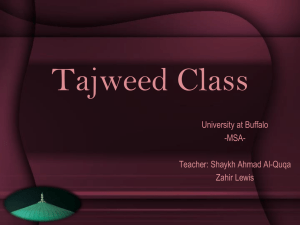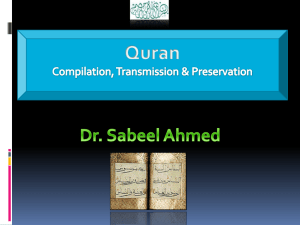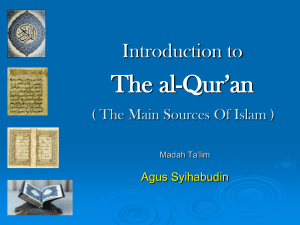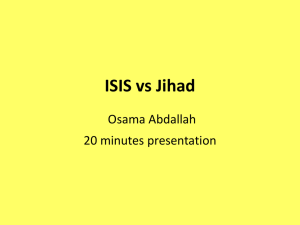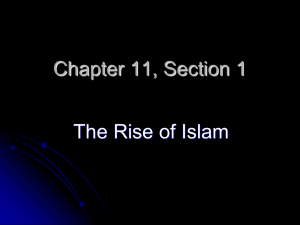Ahkam-Altajweed.Week
advertisement
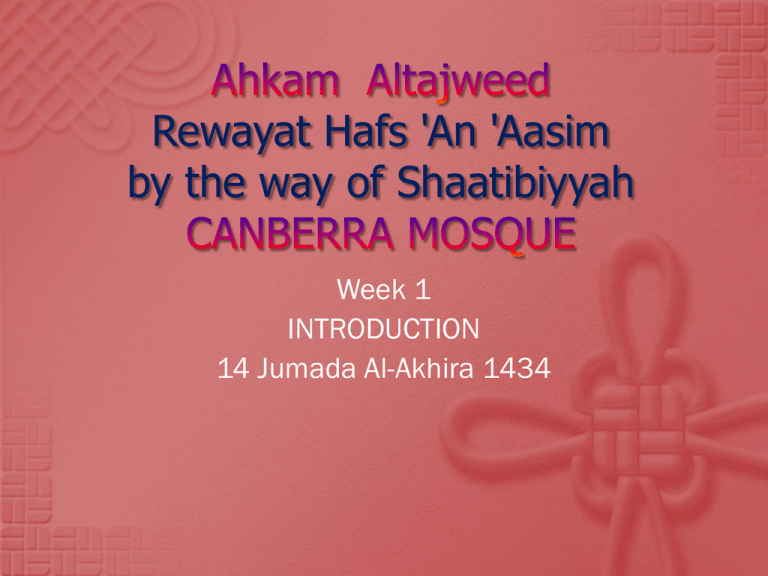
Rewayat Hafs 'An 'Aasim by the way of Shaatibiyyah Week 1 INTRODUCTION 14 Jumada Al-Akhira 1434 Ibn Mas`ud (May Allah be pleased with him) reported: The Messenger of Allah ( PBUH) said to me: "Whoever recites a letter from the Book of Allah, he will be credited with a good deed, and a good deed gets a ten-fold reward. I do not say that Alif-Lam-Mim is one letter, but Alif is a letter, Lam is a letter and Mim is a letter.'' [At-Tirmidhi] 1st Stage: Under Supervision of the Prophet Muhammad. The Prophet (PBUH) was dictating the verses orally and instructed scribes to mark down the revelation on whatever materials were available. Tree branches, stones, leather and bones were being used. The scribes would then read their writing back to the Prophet, who would check it for mistakes. He also dictated its placement within the growing body of text When the Prophet Muhammad died, the Quran has been fully written down. It was not in a book format though. The Quran was recorded on different parchments and materials, held in the possession of the Companions of the Prophet. It was also memorised in the hart of the Sahaba. 2nd Stage: Under Supervision of Caliph Abu Bakr Many of scribes who memorized the Quran in their hearts were killed in the Battle of Yamama. Some worries about the long-term preservation of the Holy Quran started arising. The Caliph Abu Bakr ordered one of Prophet Muhammad’s key scribes, Zayd bin Thabit, to initiate the process of compiling the Quran Zayed started the process by collecting the Ayat from the various type of written Quran . The Quran was fully memorised by him as well so he was verifying each verse from his own memory. He also requested that for every verse, two reliable witnesses had to testify that they heard the verse from the Prophet Muhammad, before it became accepted. The complete text of the Quran was kept in the possession of Abu Bakr and then passed on to the next Caliph, Umar Ibn Al-Khattab. After his death, they were given to his daughter Hafsah (who was also a widow of the Prophet Muhammad). 3rd Stage: Under Supervision of Caliph Uthman bin Affan As the Quran was revealed on seven letters, Companions were reading the Quran as they heard it from the Prophet. They were different and some arguments started to occur between the students who learnt it differently each from his Sheikh. Caliph Uthman bin Affan took charge of ensuring that the recitation of the Quran is of a standard pronunciation. The first step was to borrow the original compiled copy of the Quran from Hafsah. A committee of early Muslim scribes was tasked with making transcripts of the original copy and ensuring the sequence of the Chapters (Surahs). When these perfect copies have been completed, Uthman bin Affan ordered all remaining transcripts to be burned so that all copies of the Quran were uniform in script. The copy of the Quran produced was without dots and without harkat. So it enable a lot of the authentic ways to be recited using the same Mus’haf. Learning Ahkam Al-Tilawa is Fardh Kifaya so if some Muslims learnt it other Muslims will not be sinners. However, reading the Quran with Ahkam Al-Tilawa is compulsory (Fardh Ein) i.e. Muslims have to read the Quran in the way it was reveled even if he did not learn Ahkam Al-Tilawa. Tajweed linguistically - to improve and make better Tajweed technically - the correct recitation of the Qur'an that is achieved by articulating the letter from its articulation point and giving each letter its rights and due . Rights of the letter are its required characteristics that never leave it. The dues of the letter are its present characteristics that are present in it sometimes and not presented in other time. ليس التجويد بتمضيغ اللسان وال بتقعير الفم وال بتعويج(إمالة) الفك وال بترعيد الصوت وال بتمطيط الشد )تطويل الحرف المشدد) وال بتقطيع المد وال بتطنين الغنات وال بحصرمة الراءات This course will concentrate on Ahkam Al-Tilawa in Rewayat Hafs 'An 'Aasim by the way of Shaatibiyyah. Aasim is one of the seven famous readers of the Quran. Both Hafs & Shuba narrated the Quran on Aasim in two different Rewaya. Riwayatu Hafs has few different ways. Each way has different ruling. From those ways Shaatibiyya, Tayyibato Azzikr and Attayser. All those ways are Mutawatir. السورة اآلية 67 البقرة آل عمران 157 النساء املائدة 152 107 األعراف 164 التوبة 83 كيفية قراءته لها الكلمة ُه ُزواً بالواو بدالً من اهلمزة جَْي جمعُو جن بياء الغيبة والباقون بتاء اخلطاب يُ ْوتِي ِه ْم بالياء والباقون بالنون بفتح التاء واحلاء والباقون بضم التاء استج جحق ْ وكسر احلاء جم ْع ِذ جرًة بنصب التاء والباقون برفعها جمعِ جي جع ُدواً بفتح الياء وأسكنها الباقون The seven Qiraat is not the same as the seven Letters the revealed on. The scholars have different opinions about the seven Letters. The most correct view is that the different letters are different ways of reading the Quran. The differences may be in words only but have the same meaning. Or the differences may be in both words and meaning but they do not contradict each other. When the Quran was compiled by Caliph Uthman bin Affan he ordered all other copies to be burned . All the current Qiraat are in one Letter but in different Rewaya and Tareqa. When someone wants to read the Quran in a prayer he should follow one way and not to mix with other ways. Reading he Quran slowly ayah per ayah Tadabbor (thinking about the meaning) of what you read Making Wudu if you want to read from Mushaf Using Siwaq or brush your teeth before you start. Sit towards the Qiblah while reading if possible. Reading from the Mushaf. Make Sujood Tilawa if you pass Ayah with Sajdah in it. Reciting it in a melodious voice (Taghanni) which means making the voice beautiful that conveys the feelings of humility, softening of the heart and sadness, without making too much effort or exaggerating. Istiaaza, i.e saying ))أعوذ باهلل من الشيطان الرجيم, is compulsory whenever you want to read the Quran irrespective if you start from the beginning or at the middle of a Surah. The Basmallah, i.e. saying ))بسم هللا الرحمن الرحيم, has to be done at the beginning of the Surah only. There is no Basmalah in Surah Al-Tawbah. There are three speeds of reading the Quran: 1. 2. 3. Al-tahqeeq: where Quran is read very slowly with Tajweed but without Tamteet. Al-tadweer: where Quran is read at a medium pace with Tajweed Al-hadr: where Quran is read quickly with Tajweed but without combination of the letters.
